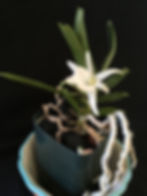Angraecum didieri
- Orchid Muse
- Jun 30, 2022
- 2 min read
One of my favorite orchid growers promises that this little angraecum is "tough as nails." It definitely is, but it's also cute as a button, and smells of spicy citrus deliciousness at night. From Madagascar, it grows in moist forests at good elevation, generally 2,000-5,000 feet.
I bought my first one in March of 2016. Here's Angraecum didieri x sib. in October 2016:

And blooming in October 2017:

I don't keep Angraecum didieri sitting in water, of course. I just snapped the picture as she was having a soak. I love the knobby roots and grassy green root tips. She also has strange fanged tips to her leaves (I think botanists describe this as "unequally bilobed").
Angraecums greatly dislike having their roots damaged. I potted Angcm. didieri in a mix of Seramis and charcoal so I can go several years without repotting it. It is generally a cool to medium grower, and appreciates high humidity (70-80% year round). Like every orchid I've ever known, good air movement will keep it healthy.
In summer, offer it no higher than cattleya (medium) light--I have it in front of a sheer-curtained southeast window. It appreciates nighttime lows in the mid-60s F, with daytime highs in the low- to mid-80s F. In its native habitat, it receives 5 to 12 inches of rain per month--which means water it a lot, but always keep it drained. I keep it in a small greenhouse, where it loves being watered from above, and good swings in day-night temperatures.
In winter, Angcm. didieri gets very little water, ranging from 0.3 inches to 2 inches per month. Ideally highs should be in the low 70s, lows in the low 50s. It also has a short winter dormancy, meaning lower light and much less water, for December and January. Its bloom season is all but the coldest four months per year.
Easy, small, and cute from its roots to its leaves--plus a scent to die for? What's not to love?

Fast forward to 2022, and it's been a reliable bloomer for me and still one of my favorite orchids. Angraecum didieri's time to bloom in my care has been April-May, often with a repeat performance in fall, and sometimes with multiple blooms. This year it's also got keikis forming at the base (yay!).

Here she is, overseeing my first-pass edits on my book, Orchid Muse. Angraecum didieri has certainly been a muse for me. I write about her in Chapter 7--the Charles Darwin chapter--and suggest that didieri is a good miniature cousin of Angraecum sesquipedale--for people who want to grow Darwin's orchid but don't have three feet of space to do it!

Happy orchiding, happy reading!